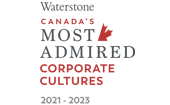Gender roles have significantly changed in the last 50-60 years. Once, women were expected to be in the labour force only until they married. Now studies show that 62% of Canadian women aged 18-65 were employed.1 Women are now better educated, hold critical roles in the corporate world, and are often the primary financial decision-makers. Despite the professional and financial successes women in the workplace have earned in recent generations, they continue to face challenges.
For instance:
- On average, women earn less than their male counterparts and often look for job flexibility (i.e., part-time hours to support family relations)2,3
- Women often leave the workforce for periods of time to care for children or other family members, thus increasing the time it takes to advance their careers, decreasing the number of years they can save for their retirement
- Women are more likely to outlive men, which means they typically need their dollars to last longer
- Women lack of confidence when it comes to financial decision making4
As a result, men’s retirement savings are 40-45% higher than those of women.5 Three out of five women feel they face significant challenges in reaching their financial goals,6 yet only 55% of women say they have a financial plan.7
Let our team of expert advisors assist you in supporting financial wellness in your workplace.
Planning for your future
Putting a plan in place is more than just saving money; it’s about prioritizing your goals, putting an action plan in place, and reaching your savings goals. The more prepared we are, the less we’ll worry and the greater the peace of mind.
Each stage of life often emphasizes different financial planning requirements:
- Early career: Paying off debt, purchasing a home, first child
- Mid-career: Focusing on children, education, travel, vacation, paying off debt
- Peak accumulation: Getting children through school, paying off a mortgage, savings increased
- Pre-retirement: Making plans, revising a will, caring for elderly parents
- Retirement: Maintaining a comfortable lifestyle
So how do we move ahead?
Identify and prioritize your goals. What’s important to you right now? Only you can identify your goals, no one else. You may be saving for a house, a wedding, a new car, a vacation, or retirement. After you’ve identified your goals, prioritize them. What needs to be accomplished soonest? What goals will take the longest to reach?
The dreaded “B” word. Set up a budget; a little pain now will be beneficial over time. Pay off high-interest debt; those interest rates will eat away your savings in the long run. Know where your retirement income will come from, and be sure to take full advantage of any company-sponsored programs. Finally, consider unexpected life events.
Learn about the fundamentals of investing. Consider tax-sheltered vehicles, learn how inflation affects your savings and discover how compounding savings works over time. Even though women tend to doubt their investment knowledge, a Fidelity study recently found that women investors achieve positive returns and surpass men by 0.4% (an analysis of annual performance across 5.2 million accounts from Jan 2011 to Dec 2020). The key reason for this? Women have more of a buy-and-hold strategy as opposed to frequent trading done by men.
Work with a financial planner. Financial planners have tools and resources at their fingertips that can help you put everything into action. Just as we use a licensed auto mechanic to repair our car, so should we entrust our finances to professional, skilled, and licensed financial planners. Research shows that over a 15-year period, investors who work with an advisor have almost four times the assets of investors who don’t.8
Equity starts with employers. If you are a plan sponsor, consider hosting financial webinars or lunch and learn sessions for female employees; it’s one way you can help support women in your workforce.
Regardless of your life stage or savings habits, now is as good a time as ever to start with some concrete actions. Put a plan in place to meet your short- and long-term goals, identify any gaps, meet with a financial planner and continue along your journey to financial independence.
Sources
- Fact sheet: Economic Security, Status of Women Canada (Government of Canada), 2015 ↵
- “Who is minding the gap?”, The Globe and Mail, March 6 2017 ↵
- Sun Life Financial “Mind the Retirement Gap” 2014 ↵
- Sun Life Financial “Mind the Retirement Gap” 2014 ↵
- Sun Life Financial “Mind the Retirement Gap” 2014 ↵
- BlackRock’s Global Investor Pulse Survey (2015) ↵
- BMO Women and Wealth Study (2015) ↵
- The Gamma Factor and the value of Financial Advice, Claude Montmarquette, Natalie Viennot-Briot, 2016 ↵






